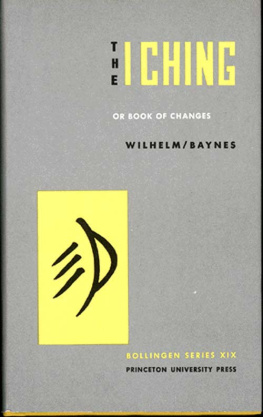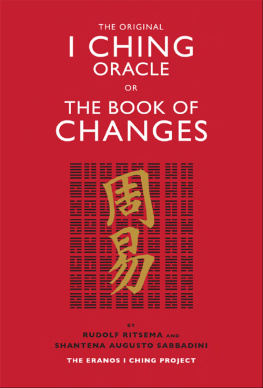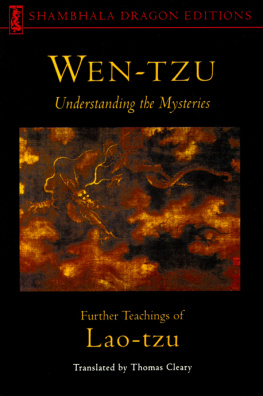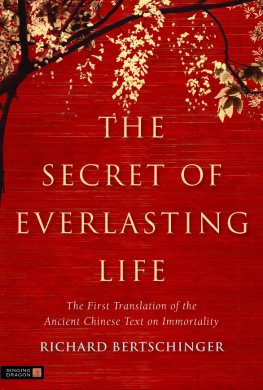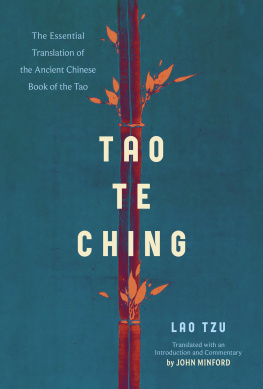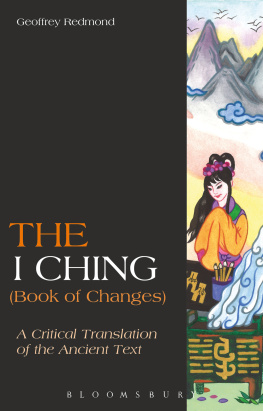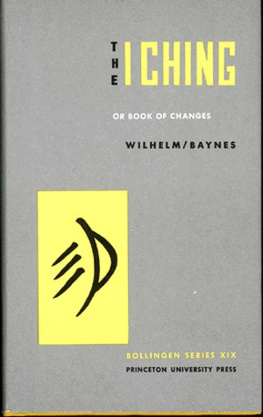The I Ching or Book of Changes
The Richard Wilhelm Translation rendered into English by Cary F. Baynes
Foreword by C. G. Jung
Preface to the Third Edition by Hellmut Wilhelm
Bollingen Series XIX
Princeton University Press
1950, 1967, renewed 1977
by Princeton University Press
Contents
PART I
PART II
It is with delight and not without a certain pride that I see this translation of the Book of Changes presented in a new edition. The fact of its widespread and continuing acceptance stands as a justification of my fathers conviction, the propagation of which he took as his calling, that the overwhelming importance of the Book within the history and the system of Chinese thought would be borne out when tested against general, and not only specifically Chinese, human conditions and against general, and not only specifically Chinese, processes of the human mind.
Since the appearance of my fathers work and its English rendering by Cary F. Baynes, two of the earlier translations have also experienced a revival: the one by de Harlez, originally published in 1889, now issued with added commentaries taken in part from my father
It will be recalled that my father began his translation more than half a century ago and that he worked on it together with one of the foremost Chinese scholars of the period, Lao Nai-hsan. Lao was, of course, in complete possession of the traditional I Ching lore, but he was also one of the most modern-minded personalities of his age. It was he who, in the context of late Imperial China, promoted institutional, legal, educational, and even language reforms of an amazingly progressive hue. Even though the tradition was for him a live concern, he was not just a tradition-bound interpreter; the concept of change, also in his own time, was part of his credo. It was his openness to the development of the traditional potential in terms of his own period that made the cooperation between him and my father so easy and so fruitful.
Much scholarship both in China and abroad has been devoted since then to a number of questions concerning the history and meaning of the text, and it might be of interest here to recapitulate briefly some of the new insights. Several lines of investigation have been followed. One of them has been the exploitation of hitherto unknown comparative material, specifically the inscribed oracle bones, which had not yet been subjected to research at the time my father worked on the Book. A second one has emerged from more advanced methods of philology and textual comparison, and a third one finally from a more advanced structural analysis of the texts themselves and of their prosodic and euphonic aspects. Taken together, these studies have added a great deal to the understanding and appreciation of the meaningful growth of the text over the centuries and to an elucidation of specific images employed in the texts.
Thus it is now widely maintained that the older layers of the text, as we know them today, assumed their present form in the century before Confucius, and that in them earlier versions of the text have been added to or even changed. Attempts have been made to reconstruct what might have been the original versions, which would be characterized by a pristine beauty of structure and euphony, in line with or superior to other texts of early Chou times. They would furthermore be characterized by a much more exclusive use of imagery as a means of expression and would be innocent of expository statements such as we find in the texts today. Attempts to differentiate an (earlier) layer of images from a (later) layer of concepts cannot, however, be called successful, and it now appears that the intimate interplay between image and concept was one of the original features of the text. The range of fields from which these images were taken must have been practically unlimited. Some of them came without doubt from the then current mythology, others from the then existing poetry (at times passages are taken over literally into the Book), others from religious and social institutions; still others seem to reflect the recognition of the archetypal configurations of specific moments in history. Many of the images used can, however, not (or not yet) be thus elucidated, and the postulate still stands unshaken that much of the imagery of the Book derives from the intuition of its original authors.
To these pristine texts there must then have been added at a very early time the so-called diviners formulae, which spell out the divinatory message implied in the images. These were both short statements about the propitiousness or otherwise of a given situation and somewhat more elaborate formulae of advice cast in a wording that involves fixed but never stereotyped imagery.
The latest discernible additions to, and changes of, the older layers of the text must have taken place, as mentioned, during the century preceding Confucius. These changes reflect a reinterpretation of the original images and concepts more intimate and more sophisticated than those of the diviners formulae. They mirror a new stage in the development of the human mind, a higher degree of self-realization, and they are expressed in ideas and positions not available to the earlier period. Most obvious among these additions is the idea of the superior man, chn-tzu, a term which meant an aristocrat in early Chou China. Some of these changes are quite incisive. Taken together, however, they represent a growth in awareness, rather than a falsification, of the original import of the Book.
The later layers of the Book, the so-called Ten Wings, have, as is recalled, been attributed to Confucius by the orthodox tradition. It can now be shown that some of the wording of at least one of them, the Wn-Yen (Commentary on the Words Other parts of the Wings must be very late Chou and possibly even post-Chou.
In addition to the endeavors outlined above, recent scholarship has concerned itself with other aspects of the Book which cannot be dealt with here. The most prominent among these is the purity of the Books system, which already amazed Leibniz, and another concerns apocryphal writings which were connected with the Book and which reflect, among other things, a developed interest in prognostication and portentology, called to life by the political battles of the day rather than by an understanding of the Books own message.
Reference has been made to recent Chinese scholarship regarding the Book of Changes. This renewed interest in the Book is fundamentally different, of course, from the one that produced the abundance of I Ching studies during Imperial times. The Book is no longer considered part of Holy Writ but is submitted to the same type of analysis as any other ancient text would be. The results have been highly rewarding. There is, however, evidence of a continued strain of reverence which has by now overcomeor more cautiously: is about to overcomethe fashion of the earlier republican times to see in the Book only a conglomerate of superstition or, at the least, murk. Everybody knows, of course, that a host of problems still remains unsolved; but sober scholarship gradually recognizes again that what has been dealt with in the Book is a unique manifestation of the human mind. The more emotionally inclined have proceeded to regard the Book again as one of the most treasured parts of the Chinese tradition. To the extent that opinions can be expressed, this is true even in the context of Communist China. Kuo Mo-jo, who until his recent purge was the foremost cultural official of Communist China, devoted himself to the Book extensively, particularly in his earlier years. And when, in the early 1960s, the ideological reins were somewhat relaxed and it was possible for a time to deal with matters of intellectual concern, the two issues which engendered nationwide discussions were the ethical system of Confucius and the Book of Changes. By now these discussions have been curtailed, but the phenomenon persists: whenever the rare chance of expression is given, the Book emerges as one of the foremost concerns of Chinese intellectuals even under the specific set of circumstances prevailing on mainland China.
Next page
